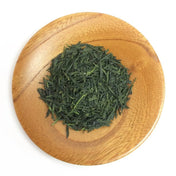Just as you put down your chopsticks after enjoying a round of nigiris at a traditional sushi restaurant in Tokyo the sushi master respectfully announces,
“Agari onegaishimasu!” (Agari please!)
A few moments later you are served hot Japanese green tea in a yunomi that is thicker and larger than the typical Japanese tea cup. The subtle astringency of the hot tea cuts through the oil of the fish leaving you and your mouth refreshed and your mind calm, alert and extremely satisfied. As you absorb the warmth of the tea and bask in the glow of a perfect sushi experience you wonder how these sushi masters so experty select and sequence the different dishes of fish, matsutake (if it is the season), rice and tea in such an incredible way.
Today we’ll investigate just the tea component in the art of sushi!
 Sushi chefs hard at work at a local sushi restaurant in Suginami-ku, Tokyo, Japan.
Sushi chefs hard at work at a local sushi restaurant in Suginami-ku, Tokyo, Japan.
The Perfect Green Tea for Sushi
Nowadays, you may find that sushi restaurants outside Japan even serve green tea. In Japan however, the green tea served to customers at a sushi restaurant is called "agari" by the sushi masters/chefs and is served to their customers for free between dishes or after the meal. Interestingly, while the sushi may be of very high quality, the tea would not be regarded as particularly exclusive. While you might expect a high quality gyokuro or sencha, those would have too much umami and would actually detract from the sushi. The green tea has a specific role in the gastronomic experience and is meant to complement rather than risk taking away from the high quality sashimi or nigiri.
Perhaps, this may take you by surprise but the green tea that is suited best for sushi is a “konacha” or powdered green tea. Konacha is tea made from bits of leaves and leaf powder produced basically as a by-product of manufacturing high quality teas such as sencha or gyokuro. Through the various sifting stages of the manufacturing and grading process the smaller, non-uniform leaves are collected and then coarsely ground to make konacha. Because konacha is more like the leftover and sifted out bits, it tends to be more affordable than tea made of full and properly shaped leaves. In this sense konacha is like kukicha (stem tea), which can similarly be an affordable way to appreciate very high quality harvests. The color is a vibrant dark green, yet the taste and aroma are not very strong. Perhaps because of this, it works wonderfully at sushi restaurants because the tea can be made easily (i.e., there is no need for a kyusu so it is hassle-free!), and the good amount of bitterness will go very well with the sushi. In fact, the konacha will help to wash down the fat from the raw fish in a refreshing way. While I am more familiar with the green tea being served at the end of a sushi meal, when served in between dishes or during the meal, it is supposed to have the purpose to reset, refresh the palate.
Some sushi restaurants may even take extra care in their green tea by blending different konachas to make their own unique konacha blend! One last thing to note is that the konacha will also be served in a bigger and thicker cup than what one may be used to. This is to retain the heat of the tea over longer periods of time and maybe to give you the time to savor the experience!
 Above, Takeo Tea Farm’s Spring Konacha Green Tea, Ichiban (JAS certified organic). Photo by Yunomi.
Above, Takeo Tea Farm’s Spring Konacha Green Tea, Ichiban (JAS certified organic). Photo by Yunomi.
Where did "Agari" come from?
If you are like me, you may have also questioned about the origins of the term “agari”. I was surprised to learn that the term actually has an intriguing (and rather bizarre) history, which dates back to the Edo period (1603 to 1867). In fact, it was first utilized in the Hanamachi district (i.e., literally meaning flower town but referring to the red light district during this time) and had no connection to sushi! In the Hanamachi district, when geishas had no customers, it was said that they were to “ocha wo hiku” (お茶を引く) which literally meant “to grind the tea”, which is what they actually did. Yet, it also served as a metaphor for wasting time. In this way, within the Hanamachi district, they started to avoid calling tea “ocha” as it was associated with bad business. Instead, to call in more fortune/customers, they started to refer to tea as “agari” because the geishas who had customers were called “oagari-san” (おあがりさん. Additionally, when the geishas did have customers the tea that was served at the end was called “Agari-bana” (上がり花) instead of “ocha” to add elegance. Simply put, “agari” replaced “ocha” as it had more of an auspicious connection. Sushi restaurants also flourished during the Edo period and since they also depended on a steady supply of customers, it is thought that the terminology caught on.
 Photo by Kazuo ota on Unsplash.
Photo by Kazuo ota on Unsplash.
Appreciating the Cup of Tea
So, did you discover anything new? Because green tea is paired so naturally with sushi at Japanese sushi restaurants, I never thought to look into what type of tea was used. I personally appreciated how the konacha is served to balance out the delicious sushi. I know that next time I am at a sushi restaurant in my motherland, I will be appreciating my Japanese green tea even more, wondering if the restaurant has their own housemade konacha blend. Oh, and as you may have noticed, I did not refer to the tea as "agari" as this is one of those special terms that only the sushi masters use for their customers!

Perhaps, not quite the yunomi (Japanese tea cup) used to serve green tea in a sushi restaurant, but this was the closest cup we had at home, an Aritayake Tea Cup. Agari is often served in a yunomi as tall as this one but tends to be thicker as the tea is very hot. At some sushi restaurants you may find the kanji characters of fish written on the cups.
Featured Image photo by George Kedenburg III on Unsplash.


